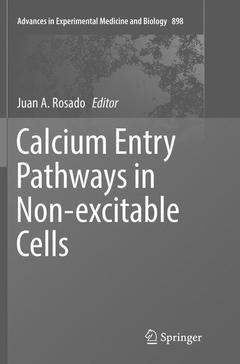Calcium Entry Pathways in Non-excitable Cells, Softcover reprint of the original 1st ed. 2016 Advances in Experimental Medicine and Biology Series, Vol. 898
Coordonnateur : Rosado Juan A.

Historical overview of store-operated Ca2+ entry.- The STIM1- Orai interaction.- The TRPCs, Orais and STIMs in ER/PM junctions.- The TRP-Na-Ca2+exchanger coupling.- Role of TRPC channels in store-operated calcium entry.- Phospholipase A2 as a molecular determinant of store-operated calcium entry.- Extracellular calcium has multiple targets to control cell proliferation.- Regulation of platelet function by Orai, STIM and TRP.- On the roles of the Transient Receptor Potential Canonical 3 (TRPC3) channel in endothelium and macrophages: implications in atherosclerosis.- Second messenger-operated calcium entry through TRPC6.- Transient Receptor Potential Canonical 7 (TRPC7), a Calcium (Ca2+) Permeable Nonselective Cation Channel.- Calcium entry through thermosensory channels.- Calcium signalling through ligand-gated ion channels such as P2X1 receptors in the platelet and other non-excitable cells.- The calcium entry-calcium refilling coupling.- Microdomains associated to lipid rafts.- Role of scaffolding proteins in the regulation of TRPC-dependent calcium entry.- Modulation of calcium entry by mitochondria.- Modulation of calcium entry by the endo-lysosomal system.- Remodeling of calcium entry pathways in cancer.
Date de parution : 05-2018
Ouvrage de 471 p.
15.5x23.5 cm
Date de parution : 05-2016
Ouvrage de 471 p.
15.5x23.5 cm
Thèmes de Calcium Entry Pathways in Non-excitable Cells :
Mots-clés :
STIM1; Orai1; TRP channels; Calcium entry; Cellular microdomains



